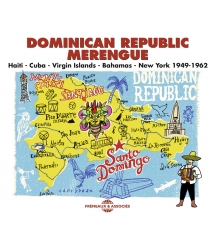Merengue, originally from Dominican Republic, was part of the international wave of Latin music in the ‘50s, but it had a rather convoluted recording history, as outlined by Bruno Blum in the very informative notes to this latest release in Frémeaux’s overview of Caribbean music history. The first CD, subtitled ‘Conjuntos – Combos’, deals with the rootsy, small ‘conjunto’ sound, consisting mainly of accordion, sax, bass, percussion and vocals, and it contains many up-tempo examples from artists such as Angel Viloria, Dioris Valladares, Luis Kalaff and others. These titles range across the whole of the collection’s time-span, and the vast majority were recorded in New York City. Merengue’s popularity rapidly expanded beyond the Dominican Republic, and the second CD looks at some of the ways it was accepted by other Latin musicians – and beyond. Haiti shares the island of Hispaniola with the Dominican Republic, but given the history of animosity between the two countries, it is still something of a surprise to find Nemours Jean-Baptiste, the pioneer of Haitian ‘kompas’ music, opening this disc of ‘Pan-Caribbean & Fusion’ with the excellent ‘Ti Yaya Toto’ from 1959. Legendary singer Celia Cruz worked with the famed La Sonora Matancera and this combination has two 1956 titles here representing Cuba, and some Puerto Rican examples can also be found here. The music was also popular enough to find its way into the repertoire of English speaking musicians, and The Virgin Islands’ LaMotta Brothers contribute several items, with leader/pianist Bill LaMotta’s ‘Poor Man’s Merengue’ (the only number of this collection sung in English) as much calypso as merengue. Though born in Haiti, André Toussaint had been based in the Bahamas for several years when he recorded ‘La Cruz’ in 1956. some of the sides on the second CD have bigger instrumentation and arrangements, including piano and larger horn sections, and the latter become more obvious on the final CD, which is subtitled ‘Orquestas – Big Bands’, and has mostly titles from the late ‘50s and early ‘60s; the sound is obviously far more sophisticated than most of what has preceded it, there is notable influence from Cuban and American big bands, and, as the notes again point out, sometimes the much later popular style of salsa is presaged. Try Antonio Morel’s powerhouse ‘El Revoltoso’ to hear just how well this approach can work… an intriguing and energetic collection then. Those interested in the influence of Latin music or the vintage music of the Caribbean can buy this with confidence.
Par Norman DARWEN – BLUES & RHYTHM
Par Norman DARWEN – BLUES & RHYTHM











